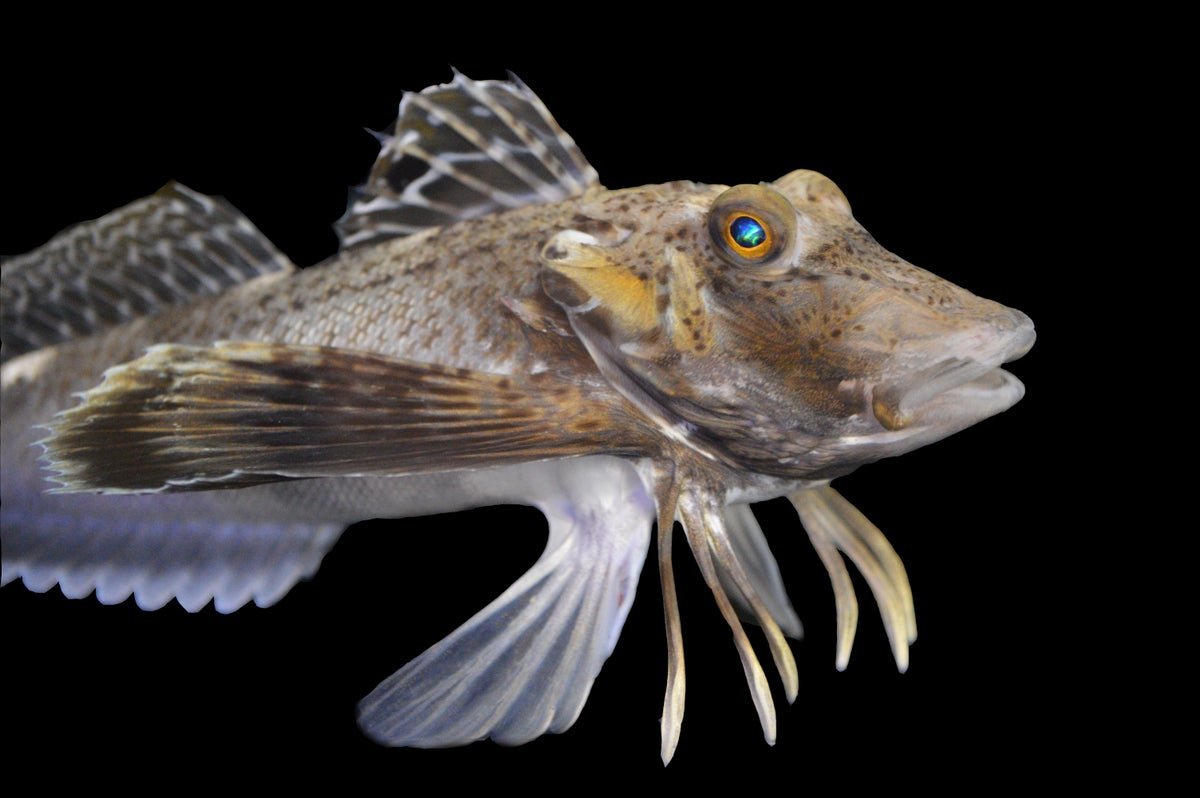David Kingsley, a professor of developmental biology at Stanford University, remembers visiting a small aquarium at the Marine Biological Laboratory (MBL) in Woods Hole, Mass., in 2016 and coming upon some walking fish. “This tank of sea robins just spun my head around because I’d never seen a fish with legs that could walk along the bottom of the tank,” says Kingsley, who is also an investigator at the Howard Hughes Medical Institute. “It was just astonishing to me to see a fish that looked like a composite of traits that incorporated the wings of a bird, the body of a fish, the legs of crabs. I mean, it was like looking at the mythical centaur—except it was real.”
Kingsley, who studies the development and evolution of stickleback fish and other animals, couldn’t put aside what he had just seen. He started feverishly working his phone on his trip home, trying to figure out if he might be able to bring his lab’s resources to study the molecular underpinnings of the evolution of a fish with legs.
“I had to take the shuttle from MBL back to Boston Logan [International] Airport,” he says. “I filled that shuttle ride with searches on Google; loaded up my phone with PDFs about this unusual fish and anything that had been done in the past. And I spent the whole plane ride back to Stanford reading about what was known about sea robins—whether it would be possible to culture them; ‘How big was their genome?’; what was known at the morphological level about where the legs come from. By the time we got back to Stanford, I thought, ‘We could do this.’”
On supporting science journalism
If you’re enjoying this article, consider supporting our award-winning journalism by subscribing. By purchasing a subscription you are helping to ensure the future of impactful stories about the discoveries and ideas shaping our world today.
What Kingsley’s team has done in the interim—in conjunction with collaborators from molecular biologist Nicholas Bellono’s lab at Harvard University—is chronicled in two new studies published on Thursday in Current Biology. Both demonstrate that Kingsley’s initial intuition was correct and that sea robins are, in fact, a rich source of insight into how evolution produces new animal traits. One of the papers focuses on a sea robin species called Prionotus carolinus—which has developed “taste sensors” in its six crablike legs. With these, it can sense a mussel or other prey below the sand and use the shovel-shaped tips of its legs to dig up its dinner. The other study examines the genetics that allowed the fish to repurpose pectoral fins into legs. Members of both Kingsley’s and Bellono’s teams were co-authors of each paper.
Sea robins are in the fish family Triglidae, some of whose species use leglike appendages to walk along the ocean floor. Some of those species can turn up in bouillabaisse, added to the soup as an ingredient with the colloquial name of gurnard. The species Kingsley encountered at MBL, P. carolinus, known as the northern sea robin, is found in shallow waters off the U.S. Eastern Seaboard. It has long drawn biologists’ attention because— besides the fact that it is able to walk along the sea bottom—some preliminary evidence suggests that it has chemical-sensing organs in its legs.
In general, biologists have found it far easier to study the evolutionary loss of traits—the disappearance of legs in snakes or the loss of pigment in cavefish—than the acquisition of new ones. So sea robins seemed like they might present a rare opportunity to look at the emergence of a specific novelty: a leg that helps the fish get around and that gives it the peculiar ability to sense and “taste” hidden prey.
Kingsley’s initial excitement was shared by Corey Allard, a postdoctoral fellow at Bellono’s lab, who has a passion for studying the biology of bizarre fish. Allard had been entranced by the sea robins during his own MBL visit in 2019. He brought the fish into the Harvard lab and began to fill in some of the blanks for the little that was known about his experimental subjects. There had been reports of other fish species following sea robins around, perhaps deputizing the legged fish as scouts to track down out-of-sight prey. Some decades-old papers had detected neural responses to touch and chemicals in sea robins’ legs—a possible clue to the presence of prey-seeking sensory organs—but that work had never been followed up. “There was almost nothing known about this organism,” Allard says. “And so we really had to start from basics that were so simple they were almost silly. We had to figure out ‘Do these fish actually dig? What do they dig for?’”
In the lab, the team observed the captive sea robins hunting for hidden shellfish below the sand at the bottom of the tank. They would walk (more like crawl) or swim for short stints and sometimes just scratch the sand. Their success in uncovering an invisible mussel suggested they could use touch and chemical sensing to find where prey might be lurking.
At one point, Allard placed an order for more fish from MBL, but the new batch was unable to find the buried prey. It turned out to be a separate sea robin species, Prionotus evolans. The mishap was fortuitous because it enabled the team to compare the distinctive course evolution took for the legs of each species. The digging species that had succeeded in hunting for buried culinary treasures had protrusions called papillae on its legs, which may have been used to feel vibrations below the sand and to sense things chemically. Comparing the two species, the researchers found that the diggers had shovellike scoops at the bottoms of their legs. The newly arrived species was only equipped with rodlike legs.
Allard says he had a revelatory moment when he was searching for clues as to how the fish were able to use their legs to chemically track prey. “I thought, ‘This is going to be like a tongue,’” he says. “‘There’s going to be taste buds on the legs, and that’s going to be the chemical sensors.’ While it is a lot like a tongue, it is also not like a tongue because there’s no taste buds on the legs. The way that it’s sensing chemicals is completely novel.” The answer to the mystery turned out be a well-known taste receptor that is used by taste buds but that in sea robins was configured in an entirely unusual way. “We saw that they were using some of the same molecules but in different cell types and in different combinations,” Allard says. “It’s kind of like when you’re playing with Legos. You buy one set, but instead you build something else with the same pieces.”
For their part, the Stanford researchers (led by geneticist Amy Herbert, a postdoctoral fellow at Kingsley’s lab) sequenced the genome of both sea robin species, noted which genes were switched on during normal development, analyzed hybrid fish they bred and determined what would happen when the genome was edited. This let them turn back the evolutionary clock. “Not only can you find the genes that’s expressed right where the legs form,” Kingsley says, “but you can target and edit that gene and know that you’ve got the right one—because you edit that gene, and the legs turn back into finlike structures.”
The genome-editing process confirmed that the gene tbx3a—encoding a venerable transcription factor known to switch on genes in vertebrates from mice to humans—was pivotal to the development of the sea robin’s legs, its papillae—and even its digging behavior. “You build new traits using old friends,” Kingsley says. “And that’s one of the things that we see in the sea robin study: yes, legs in a fish are new, but they’re generated using an ancient tool kit of genes that are well-known in other organisms.”
The studies drew the attention of other scientists. Martin J. Cohn, a professor in the department of molecular genetics and microbiology at the University of Florida, who did not participate in the research, says it is standard practice in evolutionary developmental biology studies to look for molecular mechanisms that lead to anatomical changes. “What sets this [research] apart,” he says, “is that it tackles the problem across multiple levels of biological organization. The authors identified the evolutionary changes in the sea robin genome, tested the functional consequences on skeletal and neural development by genome editing, used cross-species genetics to uncover differences in gene regulation and then undertook a behavioral study to determine how these changes impact the way that sea robins interact with their environment. It is a real tour de force.”
These broad-based approaches using new model organisms could transform the ongoing attempts to trace how new traits emerge. “With the sea robin genome and other molecular resources now available, these observations provide an entrée to understanding the genetics of evolutionarily novel attributes,” says Harold H. Zakon, a professor in the departments of neuroscience and integrative biology at the University of Texas at Austin, who wrote an accompanying commentary for the new Current Biology papers but was not involved with them.
As these studies progress, sea robins will be one of the organisms that will undoubtedly continue to receive close scrutiny. At the University of Chicago and Harvard, respectively, Herbert and Allard are now establishing their own labs dedicated to studying the biology of the legged fish.













Leave a Reply